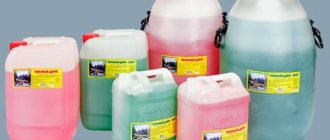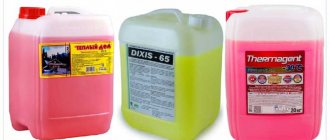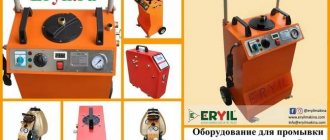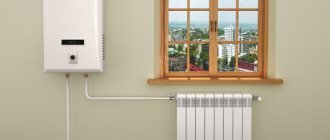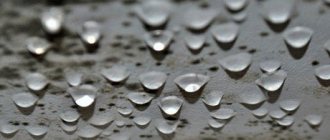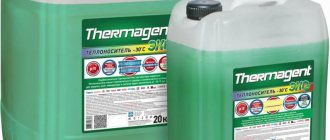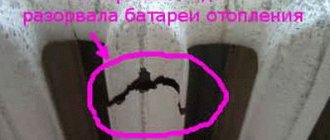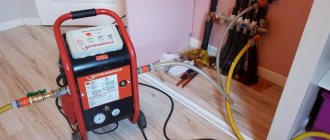Anti-freeze comes in different, bright colors. By analogy with nature - bright color means danger
In order to pour antifreeze into the heating system of your home and use it successfully, without constant worries, you need to know the rules of operation. Violation of the time and temperature limits set by the manufacturer leads to complete unsuitability of the compositions with all the ensuing consequences. One of these consequences is a change in the color of the water in the DHW circuit. Yes, this also happens, we will talk about the reasons a little later. We will also be sure to explain how the properties of the non-freezing liquid influence the choice of system elements, such as pipes, expansion tank, boiler and batteries. Now let's start with how to use antifreeze.
How to properly use heating with antifreeze
If it turns out that pouring antifreeze into the heating system of the house could not be avoided, then you need to know how to deal with it. This is a complex composition with many components. Both individual additives and their molecular bonds are created artificially in the laboratory. Of course, they were developed for use in high-temperature circuits, but there is a limit to everything.
Before you pour antifreeze into your home heating system, you should know that in order for the composition to have the characteristics specified by the manufacturer, it must be used for no more than the allotted period. Exactly as long as the integrity of the connections between the components of the composition remains stable. This period ranges from five to ten years for different liquids; more precisely, you can find out on the packaging.
Rules for using antifreeze:
- pour into clean pipes;
- do not allow too much heat;
- do not allow contact with galvanized pipes;
- avoid contact with air.
Before you pour antifreeze into the heating system of your home, you need to rinse it of all kinds of contaminants.
To do this, use different techniques:
- rinsing with water;
- chemical washing.
Both techniques are applicable in modern conditions. We have already written about how to flush the flushing fluid system. It is important that the flushing process is carried out until clean water flows from the circuit and all contaminants are removed. If this is not done, the antifreeze will not meet the stated characteristics. It’s like when painting pipes, when the quality of the protective coating largely depends on the preparatory work.
If antifreeze for heating a house boils (reviews indicate that this happens often), it can be drained and disposed of immediately afterward. A temperature of 95 degrees completely destroys the composition, it becomes extremely dangerous for all circuit elements. In addition to the fact that antifreeze itself is very caustic, overheating results in the release of acid, which aggravates the activity of the substance.
Additives precipitate. Antifreeze in the heating system of a private home begins to corrode pipes and tanks from the inside, rubber seals are especially susceptible to this. Even in working condition, antifreeze dries out the rubber. It then loses its elasticity and cracks, and when the composition becomes more aggressive, the process accelerates significantly.
If the lines are made of ferrous metal and are coated on the inside with a zinc compound, then the use of antifreeze in the heating system of a private home is prohibited. The fact is that upon contact with the protective coating of pipes, antifreeze produces a violent reaction, as a result of which a precipitate appears in the form of white flakes. It is clear that such a process destroys the structure of the antifreeze composition and, moreover, heavily pollutes the circuit. In addition, it also destroys zinc coating. As a result, both the pipes and the coolant are damaged.
You also need to pay attention to the fact that when antifreeze is cooled strongly, it becomes very viscous and its fluidity decreases. Therefore, when you start to heat the boiler after a long period of inactivity, during which the coolant has time to thicken, you need to do everything in moderation and gradually. To begin, set the heater to minimum to give the antifreeze time to warm up and become more liquid. The warmer it gets, the better the circulation will be. Gradually you need to bring the boiler operating mode to normal levels.
This approach is explained by antifreeze’s dislike of overheating. If you start firing the boiler immediately to the maximum, then the coolant that is in the boiler heat exchanger will overheat because there will be practically no circulation. The antifreeze will sit in one place for too long and will not have time to cool.
A lot of interesting things about stoves for heating cottages and their features.
Information that clearly describes autonomous gas heating of a country house, reviews and useful tips can be found here.
Why does antifreeze run out of the tap?
Water with coolant impurities may flow from the tap if you have a double-circuit boiler
Have you ever heard that for those people who use antifreeze in their heating system, water mixed with coolant pours out of their hot water tap? The case is not uncommon. What is this connected with? Let's start with the fact that this scenario is only possible if heating and hot water supply are provided by one unit. In other words, when a double-circuit boiler is installed.
In theory, the water you use in your household does not interfere with the coolant in any way. This happens if both circuits are filled with water. But in the case when antifreeze coolant is used for heating systems, the situation changes. Boilers are manufactured with water in mind. The use of antifreeze is not allowed by all manufacturers. If the unit’s passport states that it is impossible to pour antifreeze liquid, then it is better not to tempt fate. Firstly, for such freedom the unit is automatically removed from the warranty, and secondly, the prohibition is based on the characteristics of the boiler.
Antifreeze for a warm home heating system has different characteristics compared to water:
- viscous;
- thick;
- fluid.
Due to its thickness and viscosity, it is more difficult to pass through the heater nozzles, and accordingly spends more time in them. At the same time, its ability to penetrate into small cracks due to its fluidity also negatively affects the operation of the entire heating. Antifreeze penetrates where it should not, including the hot water supply circuit. As a result, the next time you open a hot water tap, you may smell a pungent odor of ethyl. This raises a serious question about what kind of antifreeze to pour into the heating system of the house. Answer: safe.
If the concentration of coolant in the hot water supply is low, then visually it cannot be noticed.
Although manufacturers paint antifreeze for heating a warm house in colors that are unnatural for the natural environment, a change in the color of hot water can only be noticed in the case of large-scale mixing. If you poured non-toxic antifreeze on a propylene glycol or glycerin basis into the circuit, then the situation is not yet critical, although the chemistry will definitely not benefit the body. If someone ignored multiple warnings about using ethylene-containing compounds, then all responsibility for the consequences falls on their shoulders.
The consequences may be as follows:
- chemical burns to the skin and eyes;
- poisoning from ingestion;
- poisoning from inhalation of vapors from the composition.
All of the above consequences are very dangerous and require urgent medical attention. Urgent means calling an ambulance, not a visit to the clinic the next day.
It is clear and step by step about autonomous heating of a private house in one article.
Read about the average cost of autonomous heating in an apartment here.
Coolant for heating system TeploDom
Coolant TeploDom - antifreeze for heating systems is suitable for various heating systems, as well as air conditioning as a working medium. TeploDom ensures stable operation in temperature conditions from minus 65°C to plus 112°C.
Heating fluid additives are designed to protect equipment from corrosion, scale and foaming, making your warm home even more reliable.
Did you know that a water heating system cooled to minus 2°C will become unusable within a few hours and require expensive repairs?
TeploDom antifreeze is perfect for plastic, metal-plastic and steel heating systems, as it does not have any effect on these materials, keeping connections, including paranit and flax, from leaking.
It is undesirable to use antifreeze and coolant for boilers in galvanized heating systems due to the possible appearance of precipitation.
Coolant-antifreeze TeploDom is somewhat more fluid compared to water and, therefore, when replacing water with antifreeze, it makes sense to additionally check the joints and perform a pressure test of the system.
Calculation of coolant in the heating system
First you need to calculate the volume of the heating system; for this it is important to know its volume parameters: boiler, pipes, radiators, expansion tank, mixing unit, etc. Add the resulting volumes in liters.
Next, you need to take into account that antifreeze for heating TeploDom -65 can be diluted with ordinary water or distilled depending on your needs, for example: 40 ° C 77% Concentrate / 23% Water 30 ° C 65% Concentrate / 35% Water 25 ° C 60% Concentrate /40% Water 20 °C 54% Concentrate /46% Water
At this temperature, crystallization is just beginning, but the liquid will begin to thicken at a temperature 5-6 degrees higher.
Equipment
Household antifreeze has a greater degree of volumetric expansion compared to ordinary water. It is necessary to select the volume of the expansion tank at the rate of at least 15% of the total volume of the heating system.
Ensure good circulation of coolant in the heating system and boilers; to do this, make sure that the circulation pump has sufficient power.
How to dilute and mix antifreeze in water.
Antifreeze for heating can be diluted with water with a high content of metals and salts, which are inherent in water from wells and boreholes. Carry out a test; if, when mixed with such water, no sediment has formed or the coolant has not become cloudy, calmly mix the entire volume of antifreeze.
If containers allow, you can mix before pouring. But it is best to mix directly during pouring, alternating portions of water and antifreeze.
Analogs
coolant warm house 65 coolant warm house eco technology of comfort coolant coolant golfstream coolant dixis 65 (dixis 65)
Questions and answers
What is the service life of the TeploDom coolant? Our antifreeze maintains high stability and guarantees operation for 5 years. Do I need to dilute antifreeze with water? It is necessary to dilute TeploDom with water, this will allow you to: save money when purchasing coolant improve circulation and increase heat capacity Is it possible to use a mixture of coolant with a lower freezing point? It is not advisable, since this can ultimately lead to equipment failure - carbon deposits in the area of the burner or heating elements. Is it possible to mix TeploDom with other coolants and antifreezes? Of course it is possible, however, it is worth checking first to see if they are combined. What happens to antifreeze after five years of use? The liquid will remain the same anti-freeze, but the anti-corrosion additives will lose their effectiveness. How to start a boiler at subzero temperatures? You should not immediately turn on the boiler, heater or heating elements to maximum power; it is better to do this gradually.
Storage
Household antifreeze (coolant) must be kept in a closed and sealed container out of the reach of children. Avoid direct sunlight on the coolant. Avoid contact with food and drinking water.
Once on skin or clothing, antifreeze is easily washed off under running water and leaves no traces of burns or irritation. In case of contact with eyes, rinse with plenty of water and consult a doctor.
Coolant production and standards
TeploDom complies with GOST 28084-89 on Low-freezing cooling liquids and is manufactured according to TU 2422-012-72021999-2011. (ethylene glycol based coolant and propylene glycol based coolant). TeploDom antifreeze is explosion- and fire-proof, has passed quality control and is approved for widespread use (certificate of conformity ROSS RU.AI 28.NO1907, state registration certificate RU.77.99.32.008.E038860.09.11).
Restrictions and disposal
It is not recommended to heat TeploDom to boiling temperature (+112°C), since when heated to 170 degrees, additives and ethylene glycol decompose.
After the expiration date, drain the coolant and dispose of it in accordance with current legislation in your region.
